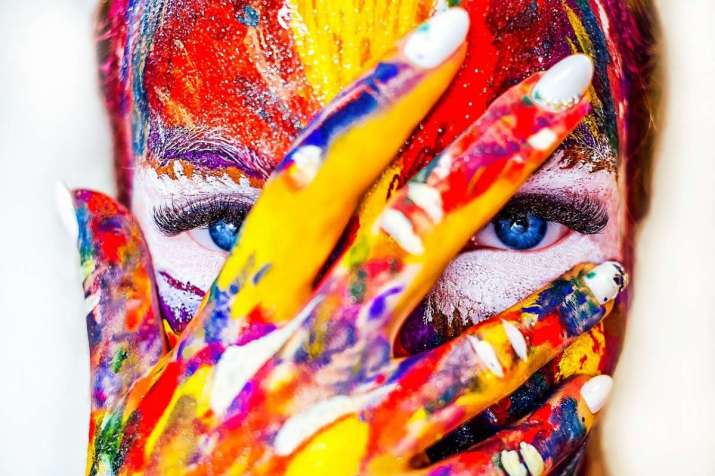
In last month’s essay, I discussed the virtues of mindful coloring along with the meditative practice of focusing on a specific deity. It’s a practice that may have deepened the feelings of relationship with your deity of choice.
Color meanings are typically learned by cultural association, yet what they symbolize to us is where the message lies. Many years ago, I was working with a client doing image-based therapy using instinctual symbol and color choices. He had chosen a color—a shade of pink that many may associate with little girls and calm—and he paired it with a symbol that actually suggested a significantly uncomfortable irritant, like a chronic rash. His association with it was something very positive, however. When we discussed it, he realized that a work situation that he’d had years of mixed feelings over had actually reached such an irritating tipping point that it prompted him to leave. This turned out to be the best outcome, setting him on a trajectory that improved his life and that of his family. It is our relationship with color, our utterly subjective and personal feeling with it, that makes the difference.
So, now you may like to gather all the images that you have colored following last month’s article, and if you have space to do so, place them in order of completion.
Firstly, note any themes. Is there a particular color, hue, or tone running through all the pictures? Is there anything else that’s apparent?
Next, separate each set of deities. Place aside all but one set and line up those images in order of completion. We worked with White Tara as the first deity, so we can start again with Her. Note any initial impressions you have. Is there any moment when there is a sudden change? Note the vibrancy of each image and, if you have kept a journal on the reverse of each image, see if you can note any correlation between the image and your emotional state at the time.
Color combinations are also something to note, as are the introductions of extra colors to the image.
When you reflect on the images, note the personal meaning that a color or combination may have for you. Colors can often symbolize a message about something that you may need to address, as well as something it is reflecting. The more vibrant the color, the greater the chances are that you have a strong, normally healthy, more grounded resonance with what that color represents in the image. The paler the color, the weaker it is or more transcendent, and the darker it is, the more shadow is introduced into that aspect and grounded may be replaced with bogged down.

How do these colors relate to the deity and what the deity symbolizes? White Tara may be, well, white, so it’d be easy to assume that there’s nothing to consider, however, that’s rarely the case. What’s the overall color theme? Is it watery or fiery? Is she earthy or celestial? Are there colors evident within her—does she have a certain hue about her or is she adorned with colors? What is she surrounded by? How do you feel about the other aspects of the image and, ultimately, how do any of the colors relate to purity, compassion, and to your health?
The key will be to sit with the images and to listen to your body. Your body will know. We can think about purity as representing our intent or core feelings about something. Are we being “pure” with ourselves or others over something? In other words, are we being authentic with regard to something or ourselves? White Tara symbolizes compassion. Along with any notes that you may have made when you did each coloring, can you tell if there is a reflection of an issue in the colors with regard to how compassionate you may need to be? Do you need to be more compassionate to yourself? Or to consider others’ situations and views more?
And when you are ready, write a journal note of the spontaneous thoughts that arise. We are still working with White Tara. Let’s say that you have surrounded her with an abundance of green. Note the hues and shades of green and how they make you feel, especially with reference to the attributes of White Tara. For example, do the greens feel healthy or sickly to you? What form have the greens taken? Are they healthy plants? Do they feel supportive or oppressive, blooming or strangling? If she is surrounded by the blackness of space, does it make you feel something? Does it feel like a void or the prima materia of creation? And how does that resonate with you? How is she adorned? Is there coloring anywhere that, on deeper reflection, appears unhealthy? It may be that, unconsciously, you’ve shaded a certain color in a part of her body that resonates with a part of your own body. Sit with these images and note the journaling upon the reverse of each image. And journal your feelings in the present as you reflect on all these images of White Tara.
There is no wrong or right to any of this. All of the colors are going to mean something to you and you alone. We can, however, be aware that certain deities have certain color attributes that are best suited to them and all they represent. Shakti energy colored in dark purple, for example, would require looking into, whereas for Kali it may feel perfect. Guanyin may feel at home in the watery blues of compassionate motherhood or a rainbow of everything-ness coming into fruition, but would feel inappropriate if used excessively for Vajrayogini, who’s better suited to the red of fire. Do you see how these colors, when spontaneously used, can represent something within us when considered along with the attributes of the deity?
Before I discuss color meanings in more detail, I propose one more exercise to practice during the next few weeks. I do not want to discuss the colors first as they may affect your instinctual choices. These are still strange days that we are living through, and for many the lockdowns, the loss of loved ones, or the material losses of work in any capacity, have left many questioning so much, not least ourselves and our place in our world. It is my hope that some of you may find some insight and healing through these simple practices that help to reveal the energy of deity in our psychological and therefore practical world.

So, in the same fashion as the first exercise, where we drew trees within a circle, (refer here if you wish to refresh your memory), we will draw instinctively. Please do not use pens or pencils however; we want to use colors only. Always ensure that you set aside enough time so that you won’t be disturbed and, if you can, apply this practice as you might any ritual whereby you may also wish to light incense or candles and prepare yourself for prayer. You’ll have had some practice with deity form during the previous exercise, should you find yourself manifesting one, but remember that this is not an art competition. Nor are we looking to assume the proportions or accoutrements associated with any art. This is purely spontaneous creation based upon the relationship between you and the attributes the deity represents in symbolic form. Place yourself in a calm and meditative state with all that you need at hand. You may wish to have some appropriate music on. You may wish to focus on a deity of choice again. You may wish to have their mantra playing, or being sung by you. And while focusing on her or him, see how your hand moves and what it manifests on the paper. You may wish to ignore the circle, you may wish to have it as a significant factor. You may wish to not focus on a particular deity at all but instead see what manifests during the session.
Either practice can be very insightful as one will have the relationship between you and the deity of choice reveal connections and or issues within yourself, while the other can reveal surprises. You may wish to sit with your image for a while after completion. This is when you can journal (you can use pen or pencil for this, of course) on the reverse of the image. Is there anything noteworthy in this image? How are you in the moment? Is there anything during the day that has impacted you and how you feel, as well as your thoughts regarding the image that you have created? This last point is not meant as a critique of your work, but more to see whether there are feelings that arise and connections you can derive from what you have drawn. Note any spontaneous thoughts that arise and how you feel. When you are ready, feel free to put it away until next month when we shall take them all out, much like we have with the coloring pieces we did last month, and take a deeper look into color and how they may connect with you.
See more
Tilly Campbell-Allen (Dakini as Art)














